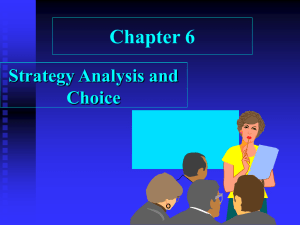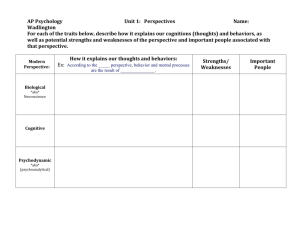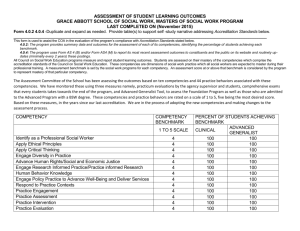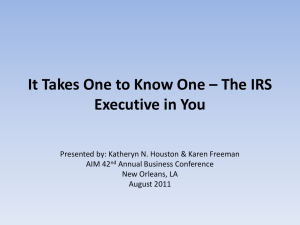Guidelines for Creating Your Personal Development Plan
advertisement
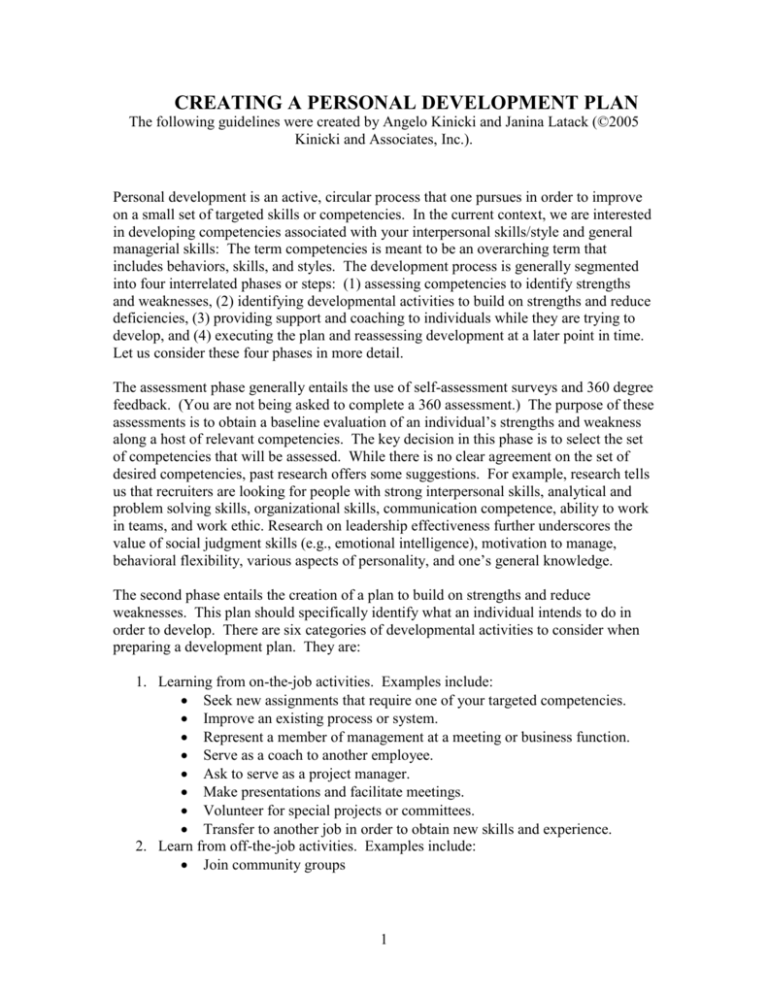
CREATING A PERSONAL DEVELOPMENT PLAN The following guidelines were created by Angelo Kinicki and Janina Latack (©2005 Kinicki and Associates, Inc.). Personal development is an active, circular process that one pursues in order to improve on a small set of targeted skills or competencies. In the current context, we are interested in developing competencies associated with your interpersonal skills/style and general managerial skills: The term competencies is meant to be an overarching term that includes behaviors, skills, and styles. The development process is generally segmented into four interrelated phases or steps: (1) assessing competencies to identify strengths and weaknesses, (2) identifying developmental activities to build on strengths and reduce deficiencies, (3) providing support and coaching to individuals while they are trying to develop, and (4) executing the plan and reassessing development at a later point in time. Let us consider these four phases in more detail. The assessment phase generally entails the use of self-assessment surveys and 360 degree feedback. (You are not being asked to complete a 360 assessment.) The purpose of these assessments is to obtain a baseline evaluation of an individual’s strengths and weakness along a host of relevant competencies. The key decision in this phase is to select the set of competencies that will be assessed. While there is no clear agreement on the set of desired competencies, past research offers some suggestions. For example, research tells us that recruiters are looking for people with strong interpersonal skills, analytical and problem solving skills, organizational skills, communication competence, ability to work in teams, and work ethic. Research on leadership effectiveness further underscores the value of social judgment skills (e.g., emotional intelligence), motivation to manage, behavioral flexibility, various aspects of personality, and one’s general knowledge. The second phase entails the creation of a plan to build on strengths and reduce weaknesses. This plan should specifically identify what an individual intends to do in order to develop. There are six categories of developmental activities to consider when preparing a development plan. They are: 1. Learning from on-the-job activities. Examples include: Seek new assignments that require one of your targeted competencies. Improve an existing process or system. Represent a member of management at a meeting or business function. Serve as a coach to another employee. Ask to serve as a project manager. Make presentations and facilitate meetings. Volunteer for special projects or committees. Transfer to another job in order to obtain new skills and experience. 2. Learn from off-the-job activities. Examples include: Join community groups 1 3. 4. 5. 6. Volunteer in an organization that would allow you to try your targeted skills Make presentations to professional or civic organizations Volunteer in religious organizations Model others who possess the targeted competencies. This may involve: Identifying people in the organization who posses the desired competency and then interview them. Try to learn how they execute the competency. Follow people around who possess the targeted competency to observe their behavior. Try out new behaviors and then discuss results with a coach or colleagues. Educational activities. Take formal courses or attend training seminars. Watch training videos and documentaries. Read books, magazines, and journal articles in search of developmental ideas. Searching the internet can help to identify relevant source materials. Experiment. Try out new behaviors and ways of working and see what happens. Discuss results with others. Consult the feedback that comes with the assessment being used. An executive coach can also be used during this phase. The coach can be used to brainstorm developmental activities and to provide feedback on your developmental ideas. Feel free to discuss developmental ideas with the TAs for this course. The third phase involves marshalling the resources and support needed to accomplish the plan. You will need to determine if you need any tangible resources (e.g., money, time, input from others) in order to work the plan. An executive coach and/or colleagues can be very helpful during this step. You also need to consider the barriers that may impede your ability to execute the plan. The final phase focuses on working the plan. It is very important to commit to your own personal development in order to foster the motivation needed to complete the plan. After a designated period of time, say 6 months to a year, you should reassess your progress in developing the targeted competencies. It is recommended that you get feedback about your progress from someone other than yourself (e.g., your boss, a colleague, direct reports, friends, or spouse). Guidelines For Personal Development People typically think about Development as “fixing”—improving problem areas or overcoming “weaknesses.” Development is not only about working on weaknesses; it also is about building strengths—capitalizing on what you do well, and getting even better at it so that you can become a star contributor to your organization. If we have a company of people working on weaknesses and nobody is working on strengths, we could end up with a company full of mediocre people! To be competitive, organizations need people who are also working on strengths, becoming even better in areas that make an important contribution to organizational goals. 2 As you think about Development Areas, be sure to consider your strengths. Because of your specific career goals, there may be a higher payoff to working on a specific strength. The issue is: Where can you and your future/current organization get the biggest payoff from your efforts? Here are the steps to follow: 1. Set aside time to read and think about the questions listed below. Your objective is to consider all of the feedback you received from the assessments and then decide on 2-3 competencies that are priority areas for building your interpersonal and managerial skills over the next two years. 2. Take out a separate sheet of paper for notes and record your answers to the questions listed below. You do not have to answer every question; these are helpful questions to guide your thinking about priority areas to develop. 3. Consider this general question when selecting priority Development Areas. “Would working on these areas support my current and future career goals, my performance goals at work, and/or my effectiveness at personally influencing others? Could working on these areas improve my ability to manage corporate change, working with others, or meet personal/family needs? A. Strengths: Which competencies were evaluated as strengths? Is this an important competency you need to model for others? Is it an area you want to improve in order to gain recognition and support? If you were to focus on this strength and improve it, would it enhance your current or future success and influence? B. Liabilities or weaknesses: What competencies were rated lowest? Are there problem areas where improvement is needed? Would working on these problem areas improve your current or future job performance? What is the biggest roadblock to your career success based on your assessments? What can happen if you don’t take action on your weaknesses? What are the areas you need to focus on to improve your ability to manage change, work with others, and influence others? Do you really want to improve? Do you really believe that you need to improve these areas? Are you motivated to change? C. Gaps: GAPS represent the extent to which you and your feedback sources agree about the frequency you engage in certain management behaviors. (Ignore any type of GAP analysis if you did not obtain feedback from others.) The smaller the GAP, the greater the agreement. Conversely, the greater the GAP, the greater the disagreement. Positive GAPS indicate that your sources believe that you display the behavior/skill/trait more frequently than you indicated in your self ratings. Positive GAPs can represent a strength you do not recognize but others do. In contrast, negative GAPS reveal that you believe you engage in a behavior/skill/trait 3 more frequently than do your feedback sources. If you obtained any type of evaluations from others, note any significant positive or negative GAPS. Are others sending you a message? Which positive and negative GAPS are most important in terms of achieving your current/future career goals? What areas do you believe represent a problem? Note: A gap is not necessarily a problem and you may need clarification from your feedback sources. For example, if your feedback sources said that you do not frequently engage in a particular behavior, and you believe that you are exhibiting this behavior frequently, the gap may not be a problem because others don’t want or need more of that particular action from you. The gap can simply be a difference of perception. Your consultation with the feedback source should clarify the cause of the gap. All told, a gap becomes a problem when it is hindering your career success or the achievement of your organization’s goals. 4. You are now ready to select 2-3 competencies/styles/behaviors for development. Do not select until you reconsider the general question that was posed earlier: “Would working on these areas support my current and future career goals, my performance goals at work, and/or my effectiveness at personally influencing others? Could working on these areas improve my ability to manage corporate change, working with others, or meet personal/family needs? 5. Write the label or description of the competency/style/behavior in the space provided on the development plan. Add any additional notes or explanation as needed 6. Complete the remainder of the development plan. It is recommended that you obtain input/feedback about your plan before submitting it for final evaluation. You are encouraged to meet with one or more members of your team to share results and ideas and to reflect on how to enhance your development. Doing this will help all involved to practice their coaching skills. Remember, coaching is a key component of managerial leadership and practice makes perfect. 4
